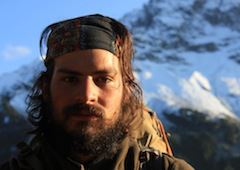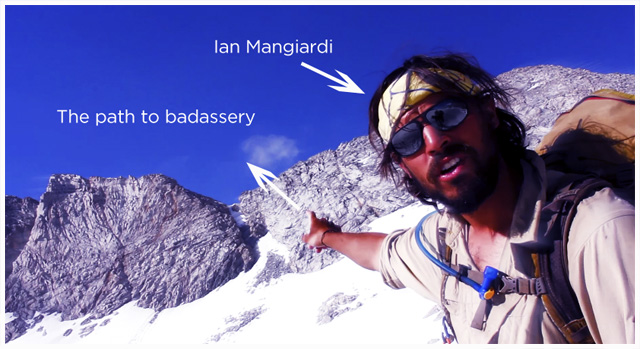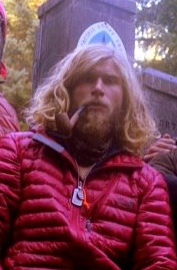Next to cat farts, Ian Mangiardi is the most commonly used phrase on this website. That is because Ian was the Good Badger’s Appalachian Trail Mr. Miyagi. He outlined my gear list, calmed my nerves, and set my expectations. Although it’s too speculative to say that I would or wouldn’t have finished without his guidance, it’s a scientific fact to discern that without him, the initial struggle would have been far greater. My goal with writing Appalachian Trials was to offer aspiring hikers this same competitive advantage, so to speak. The actual original title for the book was: “Ian’s Thoughts, Zach’s Words, Offensively Yellow Cover”.
Last year, Ian, along with his partner-in-crime Andy Laub (the other half of The Dusty Camel), thru-hiked the PCT – a mere two years after tackling the Appalachian Trail. Along the way, the duo hauled filming equipment in order to document their 2,663 mile trek from Mexico to Canada. The result is their recently premiered Pacific Crest Trail documentary, As It Happens. If I had to summarize in three words, the film is a Naturegasm Dramastorm through Adventureville. Peep the trailer below (the movie isn’t available to the public yet, but I will be the first to shout-out the good news when it is).
I caught up with the man, the myth, the Miyagi to learn more about the documentary, his beard, and how the AT and PCT compare.

Who is the star of As it Happens: You and Andy Laub, or the PCT? What was the inspiration for as it happens?
It really isn’t about the PCT. I don’t think we even mention the trail (a mix of political mumbo jumbo, and not giving support to an organization that didn’t support us) so it really is about us traveling through America, seeing its beauty and friendly faces.
How do the PCT and AT compare to one another?
The PCT and AT are like comparing apples and organs. The community around the AT is what makes it spectacular. The terrain is mundane and can get monotonous, and is way more difficult on a whole as the AT brings you up and over every peak; you end up traveling more vertical miles a day on the AT. The PCT is less known, so people rarely know what you are doing. People think you are bums or vagrants, but the beauty of the trail is much more profound. The trail winds itself through some of the tallest mountains in the country which makes the grade much less difficult. Instead of going up and over every peak, you’re wrapping around them. Even at 10,000 feet, the trail seems much more enjoyable — physically. The remote nature of the PCT is what gives its appeal, where the thousands of people surrounding the AT gives its own appeal. It’s hard to compare the two as they both equally are important in my life. They are not competing trails, but instead, contrasting trails. Where one falls short, the other excels and vice-versa.

Correct me if I’m wrong, but didn’t you and Andy thru hike the PCT on the snowiest year on record? Tell us about that experience. Did that translate to more snow hiking, zeros, or both?
Yes. Yes we did. The Sierras had over 700 inches of snow that year, and most of it was still there in June. We were five feet higher in any given point than we should have been. The snow made it difficult to navigate, and much more tiring. In wooded areas where there were trees, the areas where sun got through the trees would melt the snow, but there were still areas where the snow was kept in the shade, creating never-ending mounds of snow which we had to ascend and descend every 10 steps. Even though the mounds were only 3 or 4 feet high, going up and down them would take it out of you. Even more dangerous than the snow, however, was the snow melt. The Sierras saw 14 people die that year due to snow melt — twice as much as the usual. We just had to keep pushing ourselves through the snow. Most people skipped the Sierras that year, or went around it to go back once the snow was melted. Not us; we persevered.
If ever there was a theme to zrdavis.com, I hope it to be a never ending barrage of kicks to the poop-maker to encourage dream chasing, adventure, and passion pursuit whenever possible (spoiler alert: it’s almost always possible). In lieu of your most recent thru-hike and now documentary release, what words of wisdom would you like to espouse to the good readers of this site (not the bad ones, they’re on timeout)?
There is one simple motto which sums it all up: just do it. Excuses will be made, reasons will get in the way, life will inevitably put up a fight. When it comes to doing the things you dream about, it won’t come easily. You have to push, perceive and put your life on the line (both physically, mentally, and emotionally). The only way to achieve greatness is to fail ten times before. The only way to fail is to do. My one piece of advice is this; if you have a dream, reach for it, push yourself, and never let it go.
In total, which is harder? AT vs. PCT. “They’re different” will not be counted as an answer. (Clearly you were dealt a crazy difficult hand for each. The hiking Gods like watching you and Andy suffer.)
Yes, the gods like dumping snow on us and watching us shiver and quiver. The AT was the highest snow year for the south in the midst of the hike, and the PCT was the highest snow year EVER for the Sierras. The AT is actually more difficult physically and mentally but the PCT is more difficult logistically. Since the AT goes over every single little peak in its way, its physically more strenuous, and since the terrain is similar throughout the trail — its mentally challenging due to the monotony. The PCT varies in terrain DRASTICALLY throughout it’s miles. From the desert to high mountains, and everything in between. However, the difficulties on the PCT are logistically. It is in the middle of nowhere, and difficult to find rides into towns so far away. The community around the AT make it much more enjoyable at times, and the PCT has a very small community which doesn’t help with rides getting into town (people think your bums, and know nothing of the trail!). So while the trails are DIFFERENT (ha!) they both have their hardships and beauty.
Will the PCT ever match the AT in terms of popularity?
No. The PCT is in some of the most remote lands of the country and the towns which are closest to the trail can reach up to 30 miles away. The AT swivels through tons of towns which rely on the hikers for their economy. This means people all around the trail know who hikers are, what their doing, and offer help. This brings more people to the trail since it can get to be a party at times. Community drives popularity, and vice versa. The PCT lacks both in the grand scheme of things — which makes it sought after by experienced hikers looking for a less populated trail and experience.
When traversing an ice covered, steeply sloped mountain, where one slip translated to impeding death, did the thought, “what the fuck am I doing?” ever cross through your mind?
What the FUCKING FUCKITY FUCK FUCK went through my mind often. Why am I doing this also crossed my mind many times. Through all the blisters, broken gear, broken spirits — it was hard to find reasons at all times to be out on the trail. One night after our Mt. Whitney climb, I realized why I do these journeys: to experience a moment most will never know.
Scenario: Go back in time and allow the negative thoughts and excuses to persuade you out of doing the AT + PCT. How is your life different? How are you different?
Myself and my life are no where near what it is today. The AT inspired me to better myself and turn me into the person I am today, and the PCT gave me the drive to excel my career and ambitions forward. Essentially the AT straightened the arrow, and the PCT shot it that arrow far. It’s impossible to think where I would be without these trails, but I can say with confidence I would not be who I am today.
The cinematography is bananas good (on the motion-picture-fruit scale, that’s the highest score). Did you have any film training prior to embarking on the trail?
While the doc was partially shot by myself, it is primarily shot by Andy. He is a videographer and has worked at major channels from Discovery to TLC. Andy is really the brains behind the doc, where I am the brains behind the expedition. This pairing allows us to capture some spectacular shots in some spectacular lands.
How heavy was the camera + electronic gear? How heavy was your pack in total? How much did it slow you down – not only in terms of weight, but capturing footage?
It didn’t slow us down at all! Part of my responsibility was to create our gear lists. Depending on areas, our base pack weight (excluding water and food) was anywhere from 13-30 pounds. The camera equipment and electronics combined only weighed about 10 pounds, so between the two of us was nothing. I did my research to ensure all of our equipment was as light as possible to make up for the additional weight of our electronics, and it worked beautifully. The way we carried the camera was with a holster style pack that was clipped on to our hip straps. The Camera was only a quick zip away to capture a shot in the moment and while on the move. This ensure we could move quickly and shoot quickly.
Did you name your beard? If not, please do so now.

Our beards weren’t named, but we had trail names for our trail names in part from our long beards, and in part for the screws in our head coming loose. I was Sheriff Dusty, and Andy was Camel the Viking. I always had the King Tut style beard (long under the chin but short on the sides), so if it had a name it — Kind Tut would be his name!
You hit an emotional low while hiking through Oregon. Do you think you would’ve finished without knowing that a documentary was on the line? If not, what got you through the most challenging days?
As we often said on the AT — we are locked in a prison with the key in our hands. If the doc wasn’t on the line, we would have persevered regardless. The lows we felt were drastically outweighed by the highs, especially once completed. No matter how bad we felt, or how much we wanted to go home, the thought of quitting was never an option or even crossed the mind. The thought of going home, and the thought of getting off trail were frequent fliers through our minds, but we always knew we would be on it until Canada.
The scene where you catch a trout flyfishing is really badass. That’s not a question, yet still very important.
Badass, and delicious. Those trout were not only beautiful — but tasty! It was a much needed mental pickup. Sometimes you can get lost in the grind of hiking and forget to take your time and smell the flowers, and catch a fish. Taking those moments really allows you to appreciate where you are and what you’re doing.
Andy’s hair is magical. Also not a question, but still needs to be said. Please comment.
Its a beast. An unruly, untamable beast. He washed it maybe a dozen times in six months… maybe.
What’s next?
As mentioned before, the PCT gave me the drive to excel my career forward. I am starting two companies in LA which are and will be outdoor related. I will continue to manage expeditions and work to get people outdoors, and I look forward to the future. There is a saying in the long distance backpacking work when talking about the AT; “you either do one trail, or three…” we’ve done two. The third, the Continental Divide Trail, will not be far away.
Want even more? Zach and Steve interview Andy on their latest podcast. Listen here. Also, I have a new podcast. We’ll talk about it more later. I’m going to sleep now. Dibs on little spoon.


